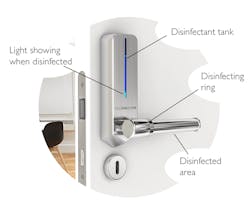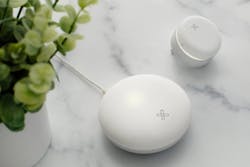
This article originally appeared in the February 2021 issue of Security Business magazine. When sharing, don’t forget to mention @SecBusinessMag on Twitter and Security Business magazine on LinkedIn.
Welcome to our annual CES issue! As the only security industry magazine/website dedicated to fully covering a show focused on cutting-edge consumer tech, we believe that these innovations not only give security industry practitioners, integrators and developers a look at the current smart home and cybersecurity landscape, but they also give us a glimpse into the future of where our technology is headed.
Utilimedic, a division of vehicle technology company Namsung America, demoed its UV8LED, an in-car phone sanitizer with wired and wireless charging. This UV light sanitation device can be plugged into a vehicle’s 12V socket and mounts on a dashboard. For our industry, think about how this might be valuable to a security technician or salesperson who, for example, needs to use a phone or small tablet to obtain customer signatures or payments.
In the door hardware realm, CleanMotion, a Swiss start-up (https://cleanmotion.ch), gave me a look at its “immediate self-disinfecting door handle” – which disinfects a door handle after every touch. The user loads a compartment (located where the battery holder or the pushbutton panel would be on a traditional smart lock) with the disinfectant, a sensor determines when the handle is released, which activates a disinfectant ring that moves up and down along the surface, eliminating 99.9% of bacteria by spreading the sanitizer. Sounds like a high-tech way to bring a low-tech version of an anti-microbial coating (they can’t all be winners).
Future Tech: Wi-Fi Sensing
The rise of ultra-fast Wi-Fi 6 has opened up possibilities for expanded security technologies in the home. In a report prepared for NXP Semiconductor, Andrew Zignani, Principal Analyst for ABI Research’s Strategic Technologies team, says: “New enhancements to Wi-Fi technology, such as Wi-Fi 6 and 6E, can help better serve a mixture of device types, from high-throughput video applications, such as smart TVs, AR/ VR, voice assistants, and IP cameras, to low-cost and power-sensitive sensor and monitoring devices, as well as a whole host of other devices ranging from thermostats and smart lighting to other connected home devices.”
One company I saw at CES takes this prediction to heart, and in fact, presented an intrusion/occupancy detection system based completely on “Wi-Fi Sensing technology.”
In 2013, in collaboration with University of Maryland research, Origin Wireless AI discovered that Wi-Fi could be used for sensing by calculating how Wi-Fiwaves bounce, break, and bend around people. Now ready for commercialization, Origin says the logical entry point was the home security market.
“Origin realized it could protect an entire home with just a few Wi-Fi devices,” a product release says. “This led to the creation of Hex – a simple to use, extremely accurate home security system that is solving some of the biggest challenges in the security industry.”
I attended a virtual demo of the product. The company claims it reduces false alarms and provides room occupancy detection in non-alarm mode. It certainly works well for “alarm away” situations, but so far has no adaptability to “alarm stay” mode – something that many users deploy, especially with so many at home all the time right now (personally, my alarm system is most valuable when I am home sleeping). Still, I would expect that Wi-Fi sensing is another budding technology about to be harnessed by more in our industry.
In addition to the great CES content included in this issue, I encourage you to embrace the possibilities by checking out our full coverage at www.securityinfowatch.com/ces.
Paul Rothman is Editor-in-Chief of Security Business magazine (www.securitybusinessmag.com). Email him your comments or topic suggestions at prothman@securitybusinessmag.com.

Paul Rothman | Editor-in-Chief/Security Business
Paul Rothman is Editor-in-Chief of Security Business magazine. Email him your comments and questions at prothman@securitybusinessmag.com. Access the current issue, full archives and apply for a free subscription at www.securitybusinessmag.com.



